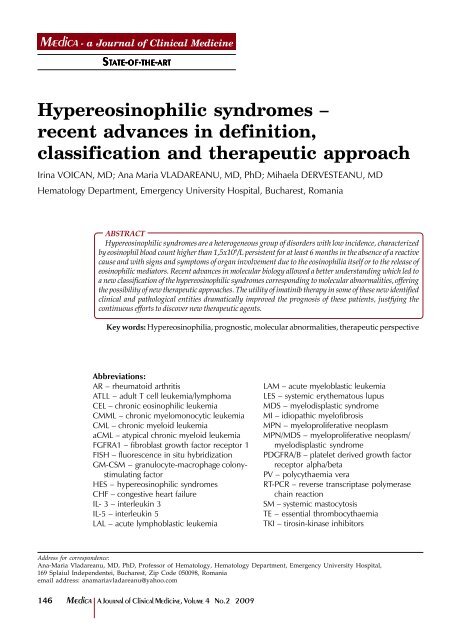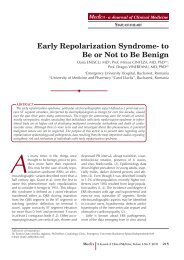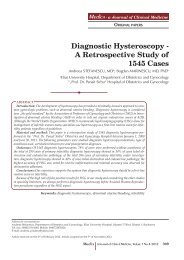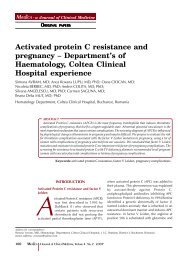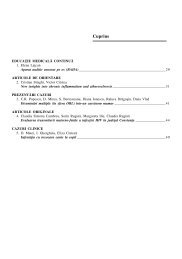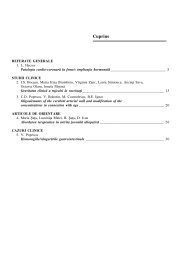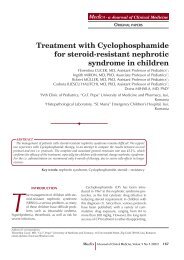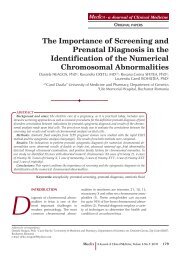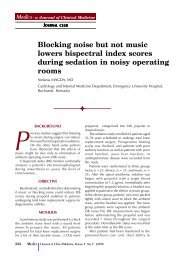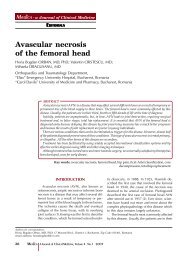Hypereosinophilic Syndromes â Recent Advances In Definition
Hypereosinophilic Syndromes â Recent Advances In Definition
Hypereosinophilic Syndromes â Recent Advances In Definition
Create successful ePaper yourself
Turn your PDF publications into a flip-book with our unique Google optimized e-Paper software.
M K pag 146Mædica - a Journal of Clinical MedicineSTATETE-OFOF-THETHE-ARART<strong>Hypereosinophilic</strong> syndromes –recent advances in definition,classification and therapeutic approachIrina VOICAN, MD; Ana Maria VLADAREANU, MD, PhD; Mihaela DERVESTEANU, MDHematology Department, Emergency University Hospital, Bucharest, RomaniaABSTRACT<strong>Hypereosinophilic</strong> syndromes are a heterogeneous group of disorders with low incidence, characterizedby eosinophil blood count higher than 1,5x10 9 /L persistent for at least 6 months in the absence of a reactivecause and with signs and symptoms of organ involvement due to the eosinophilia itself or to the release ofeosinophilic mediators. <strong>Recent</strong> advances in molecular biology allowed a better understanding which led toa new classification of the hypereosinophilic syndromes corresponding to molecular abnormalities, offeringthe possibility of new therapeutic approaches. The utility of imatinib therapy in some of these new identifiedclinical and pathological entities dramatically improved the prognosis of these patients, justfying thecontinuous efforts to discover new therapeutic agents.Key words: Hypereosinophilia, prognostic, molecular abnormalities, therapeutic perspectiveAbbreviations:AR – rheumatoid arthritisATLL – adult T cell leukemia/lymphomaCEL – chronic eosinophilic leukemiaCMML – chronic myelomonocytic leukemiaCML – chronic myeloid leukemiaaCML – atypical chronic myeloid leukemiaFGFRA1 – fibroblast growth factor receptor 1FISH – fluorescence in situ hybridizationGM-CSM – granulocyte-macrophage colonystimulatingfactorHES – hypereosinophilic syndromesCHF – congestive heart failureIL- 3 – interleukin 3IL-5 – interleukin 5LAL – acute lymphoblastic leukemiaLAM – acute myeloblastic leukemiaLES – systemic erythematous lupusMDS – myelodisplastic syndromeMI – idiopathic myelofibrosisMPN – myeloproliferative neoplasmMPN/MDS – myeloproliferative neoplasm/myelodisplastic syndromePDGFRA/B – platelet derived growth factorreceptor alpha/betaPV – polycythaemia veraRT-PCR – reverse transcriptase polymerasechain reactionSM – systemic mastocytosisTE – essential thrombocythaemiaTKI – tirosin-kinase inhibitorsAddress for correspondence:Ana-Maria Vladareanu, MD, PhD, Professor of Hematology, Hematology Department, Emergency University Hospital,169 Splaiul <strong>In</strong>dependentei, Bucharest, Zip Code 050098, Romaniaemail address: anamariavladareanu@yahoo.com146Mædica A Journal of Clinical Medicine, Volume 4 No.2 2009
M K pag 147M K pag 147HYPEREOSINOPHILIC SYNDROMES – RECENT ADVANCES IN DEFINITION, CLASSIFICATION AND THERAPEUTIC APPROACHThe eosinophil granulocytes are mature leukocytesdifferentiated from CD 34+ myeloidprecursors cells. Production and maturation ofeosinophils take place in the bone marrow andis promoted by cytokines: GM-CSM, IL-3 andespecially IL-5 (a product of CD4+ T-lymphocytes),which appears to be the dominant eosinophilgrowth and survival factor. Thesecytokines are also resposible for the inhibitionof eosinophilic apoptosis (1).Following maturation, eosinophils circulatein blood and migrate to inflammatory sites intissues, or to sites of helminthic infection in responseto certain chemokines (eotaxin-1,eotaxin-2, RANTES), and leukotrienes (leukotrieneB4). At the infectious sites, eosinophilsare activated by Type 2 cytokines released froma specific subset of helper T cells (Th2).Eosinophils are normally found in the bonemarrow, at the junction between the cortex andmedulla of the thymus, in the lower gastrointestinaltract, respiratory structures, ovary, uterus,FIGURE 1. Mature eosinophil and precursors –MGG (40X). (3)FIGURE 2. Mature eosinophil –MGG (100X). (3)spleen, and lymph nodes. The presence of eosinophilsin other organs is associated with disease(2).When examined by standard blood-stainingtechniques, the mature eosinophil is 12-17micrometers in size, with bilobed nucleus andabundant cytoplasm filled with large reddishorange(eosinophilic) granules that do not coverthe nucleus (FIGURES 1 and 2).Eosinophils play an important role in fightinghelminth colonization, viral and fungal infections,they are important mediators of allergy(including asthma pathogenesis). Eosinophilsare also involved in fibrin removal duringinflammation, postpubertal mammary glanddevelopment, oestrus cycling, allograft rejectionand neoplasia. They have also recently beenimplicated in antigen presentation to T cells.Following activation, the eosinophilsdegranulate and release their content: majorbasic protein (MBP), eosinophil cationic protein(ECP), eosinophil peroxidase (EPO), eosinophilderivedneurotoxin (EDN), capable of inducingtissue damage. ECP and EDN are ribonucleaseswith antiviral activity. MBP induces mast cell andbasophile degranulation, and is implicated inperipheral nerve remodeling. ECP creates toxicpores in the membranes of target cells allowingpotential entry of other cytotoxic molecules tothe cell, can inhibit proliferation of T cells, suppressantibody production by B cells, inducedegranulation by mast cells, and stimulate fibroblastcells to secrete mucus. EPO stimulatesreactive oxygen species and promotes oxidativestress causing cell death by apoptosis andnecrosis (4). Other mediators released by eosinophilsare growth factors (such as TGF beta,VEGF, and PDGF), cytokines (such as interleukinand TNF alpha), enzymes (elastase), leukotriensand prostaglandins.<strong>In</strong> normal individuals eosinophils make upabout 1-6% of white blood cells but the absoluteeosinophil count (AEC) seems more correctand is preferred by most authors. The detectionof more than 0.6x109/L eosinophilsdefines eosinophilia.Classification of eosinophilia by its degreemay be the initial clue for diagnosis (TABLE 1, (5)).Classification of eosinophilia (6):1. familial eosinophilia – autosomal dominantdisorder with constant number ofeosinophils and a benign evolutionMædica A Journal of Clinical Medicine, Volume 4 No.2 2009 147
M K pag 148M K pag 148HYPEREOSINOPHILIC SYNDROMES – RECENT ADVANCES IN DEFINITION, CLASSIFICATION AND THERAPEUTIC APPROACHTABLE 1. Causes of eosinophilia [adapted from M.L.Bridgen (5)]2. acquired eosinophilia:• primary – clonal; idiopathic (HES)• secondary eosinophila – as reactivephenomenon in allergy, infection ormalignant diseasesPrimary eosinophilia is not reactive. It isclonal when a molecular or cytogenetic abnormalityis identified and idiopathic when bothclonality and any known cause ofhypereosinophilia are excluded.<strong>In</strong> 1968, Hardy and Anderson first used theterm <strong>Hypereosinophilic</strong> Syndrome to describepatients with prolonged eosinophilia of unknowncause and organ damage due to eosinophilicinfiltration.<strong>In</strong> 1975, Chusid et al used three diagnosticcriteria for HES (4):– persistent eosinophilia of >1,5 x 10 9 /Lfor more than six months– lack of evidence for reactive eosinophilia– organ involvement<strong>In</strong> 2005, in Bern, on behalf of <strong>Hypereosinophilic</strong><strong>Syndromes</strong> Working Group, Klionet al proposed a new classification for the multitudeof hypereosinophilic pathogenic variantsand divided them in subtypes (7-10):– FIP1L1-PDGFRA (F/P) – associated HESor F/P + HES: patients with clonal hypereosinophiliadue to chromosomal rearrangementresulting in FIP1L1/ PDGFRA –fusion gene on 4q12.– Chronic eosinophilic leukemia (CEL) –patients with proven eosinophil clonality(including FIP1L1-PDGFRA fusion gene)or with increased marrow blasts; someof these cases may have acute leukemiaevolution.148Mædica A Journal of Clinical Medicine, Volume 4 No.2 2009
M K pag 149M K pag 149HYPEREOSINOPHILIC SYNDROMES – RECENT ADVANCES IN DEFINITION, CLASSIFICATION AND THERAPEUTIC APPROACH– Lymphocytic-HES (L-HES): patients withchronic reactive eosinophilia in responseto IL-5 over-production by T cells.– Myeloproliferative-HES (M-HES): patientswith a large array of clinical and biologicalfeatures (elevated levels of vitaminB12, hepatomegaly, splenomegaly, anemia,thrombocytopenia, circulating myeloid,displastic eosinophils, bone marrowhypercellularity with increased numberof myeloid precursors, myelofibrosis,increased serum tryptase and responseto imatinib), suggesting an underlyingmyeloproliferative disorder associatedwith eosinophilia but having no evidenceof molecular defects.– Idiopathic hypereosinophilic syndrome(HES): patients with eosinophilia of unknowncause.– Organ-restricted eosinophilic disease:only one specific tissue or organ involvement(e.g. eosinophilic esophagitis, eosinophilicgastroenteritis, eosinophilic pneumonia,Kimura disease, eosinophilic dermatitis,eosinophilic fasciitis)Although this rather complicated classificationraised multiple debates regarding its accuracy,it proved to be useful for defining certainpathogenic entities (11).Lately, new molecular data improved thediagnosis guidelines of the eosinophilic disordersand an entirely new classification emerged(WHO classification of tumors ofhaematopoietic and lymphoid tissues 2008).The following entitis are now acknowledged(12):Chronic eosinophilic leukemia (CEL) definedas a clonal proliferation of eosinophilicprecursors, accumulation of eosinophils in peripheralblood and bone marrow, causing endorgan damage due to the tissue eosinophilicinfiltration and release of eosinophilic proteins.Patients expressing Philadelphia chromosome,BCR-ABL1, PDGFRA, PDGFRB and FGFR1 fusiongenes are excluded.Diagnosis criteria:– AEC>1.5 x 10 9 /L in peripheral blood orbone marrow eosinophilia– exclusion of reactive causes of eosinophiliaincluding hematological malignancies(e.g. aCML, CML, CMML andlymphoproliferative disorders)– exclusion of a T-cell abnormal populationthat produces increased eosinophilopoieticcytokines– peripheral blood blasts >2% and bonemarrow blasts 5% – 20%or– evidence of eosinophil clonalityIf the clonality of the eosinophils cannot bedemonstrated and bone marrow blasts are lessthan 5%, the term “Idiopathic HES” must beused.Idiopathic HES: is a diagnosis of exclusion.<strong>In</strong> time, some of these patients initially diagnosedas Idiopathic HES may develop clinicalfeatures resembling CEL or hypereosinophiliainduces by cytokines (IL-2, IL-3, IL-5).Diagnosis criteria:– persistent eosinophilia (AEC >1,5 x 10 9 /L) for more than 6 months– exclusion of reactive causes of eosinophilia– exclusion AML, MPD, MDS, MPD/MDSand SM– exclusion of a T-cell abnormal populationwith increased production of eosinophilopoieticcytokines– end organ damage– no the evidence of eosinophilic clonality(exclusion of Philadelphia chromosome,BCR-ABL1, PDGFRA, PDGFRB andFGFR1 fusion genes, myeloproliferativedisorders as PV, ET, IMF or MPD/MDSare excluded).Idiopathic hypereosinophilia includes allthese criteria except for end organ damage.Myeloid neoplasms (MPN) with eosinophiliaand PDGFRA, PDGFRB and FGFR1 rearrangements:three distinct entities with cytogeneticabnormalities resulting in fusion geneswith tyrosine-kinase activity; some of them areimatinib sensitive. The hematological featuresare those of myeloid or lymphoid neoplasms.PDGFRA rearrangement: usually presentsas CEL +/- mastocitosis and less often as AMLor lymphoblastic lymphoma with eosinophilia.These patients present clinical features of achronic disease with constitutional symptoms(weakness, weight loss, night sweats, pruritus)and virtually any organ may be involved: heart,lungs (restrictive dysfunction with fibrosis), gastrointestinaltract, skin, spleen, rarely liver. Somepatients progress to acute forms. Prognosis dependsmainly on the cardiac involvement(endomyocardial fibrosis with restrictive cardi-Mædica A Journal of Clinical Medicine, Volume 4 No.2 2009 149
M K pag 150M K pag 150HYPEREOSINOPHILIC SYNDROMES – RECENT ADVANCES IN DEFINITION, CLASSIFICATION AND THERAPEUTIC APPROACHomyopathy, heart failure, mitral or tricuspidvalves dysfunctions, mural thrombi with highthromboembolic risk). Both chronic and acuteforms are associated with imatinib response. Themost frequent genetic abnormality is a crypticinterstitial deletion in chromosome 4 (4q12)leading to FIP1L1-PDGFRA fusion geneDiagnosis criteria:– AEC >1,5 x 10 9 /L– 5-19% bone marrow blasts– no evidence of Philadelphia chromosome– no evidence of BCR-ABL fusion gene– demonstration of del 4q12 (being a crypticfusion gene FISH exam is required,cytogenetic analysis alone is insufficient)or of FIP1L1-PDGFRA fusion gene (confirmedby RT-PCR or nested RT-PCR).Other PDGFRA molecular variants areassociated with imatinib sensibility.(13,14)PDGFRB rearrangement: the hematologicalfeatures are most often those of CMML witheosinophilia and a variable degree of mastocytosis.Mandatory for the diagnostic of thesemyeloproliferative neoplasms is the presenceof PDGFRB gene. Patients often have splenomegaly,skin infiltration and cardiac damage butrare liver involvement. Peripheral blood andbone marrow are always involved. Evolution toacute leukemia may occur. Imatinb producesclinical response. Prognosis mainly depends onthe cardiac damage. Cytogenetic analysis usuallyshows t(5;12)(q31~33;p12) with the translocationresulting in formation of an ETV6-PDGFRB fusion gene.Diagnosis criteria:– myeloid neoplasm with prominent eosinophilia+/- neutrophila or monocytosis– evidence of t(5;12)(q31~33;p12) or avariant translocation (cytogenetic analysis)or demonstration of an ETV6-PDGFRB fusion gene or rearrangementsof PDGFRB (PCR or FISH)– no evidence of Philadelphia chromosomeFGFR1 rearrangement: some patientspresent as T cell lymphoblastic leukemia/lymphoma,CEL, AML and less often as precursorB cell lymphoblastic leukemia/lymphoma. It representsa heterogeneous group of disorderscharacterized by lymph nodes involvement,splenomegaly, fever, weight loss and nightsweats. A variety of translocations with an 8q11breakpoint can underlie this syndrome. Theprognosis is poor since no TKI has proved effectivein FGFR1 rearrangement neoplasms. <strong>In</strong>terferonhas induced a cytogenetic response inseveral cases. Haematopoietic stem cell transplantationshould be considered even in thosepatients who present in chronic phase.Diagnosis criteria:– myeloid neoplasm with increased eosinophilia+/- neutrophila and/or monocytosisor– acute myeloid leukemia or precursor Tor B cell lymphoblastic leukemia/ lymphomaprecursors AND– presence of t(8;13)(p11;q12) or a varianttranslocation leading to FGFR1 rearrangementdemonstrated in myeloidcells, lymphoblasts or both.The above mentioned data represents thenew approach of the clonal hypereosinophilias,based mainly on cytogenetic and molecular assays.Several conclusions must be emphasized:1. According to this classification, older entitiesas myeloproliferative-HES and lymphocytic-HESare no longer used, beingconsidered as secondary hypereosinophilia.2. New entities with major therapeutic impactare defined based on cytogeneticand molecular criteria3. Immunophenotypic analysis is less importantin diagnosis as long as the clonal eosinophilshave no particular characters butit has its role in identification, characterizationand following of the abnormal T-cell population that produces excessivelyIL-5.4. The cytogenetic analysis should alwaysbe followed by molecular assays, especiallyin myeloproliferative-like disordersthat may have cryptic anomalies.5. Any MPN or lymphoblastic leukemia/lymphoma with eosinophilia require cytogeneticanalysis for PDGFRB, FGFR1 rearrangementsand molecular assays (RT-PCR or FISH) for PDGFRA rearrangements.150Mædica A Journal of Clinical Medicine, Volume 4 No.2 2009
M K pag 151M K pag 151HYPEREOSINOPHILIC SYNDROMES – RECENT ADVANCES IN DEFINITION, CLASSIFICATION AND THERAPEUTIC APPROACHDiagnostic algorithm for blood eosinophilia (FIGURE 3)FIGURE 3. The diagnostic process in a patient with hypereosinophilia [adapted after SFletcher, B Bain (15)]TABLE 2. <strong>In</strong>vestigations that are indicated in a patient with unexplained persistenthypereosinophilia (15)<strong>In</strong> addition to looking for the cause of eosinophilia,laboratory tests to assess possible eosinophilictissue damage may be required andinclude electrocardiography, echocardiography,pulmonary function tests, CT scanning of thechest, abdomen and pelvis and, in presence ofsymptoms, tissue biopsy (FIGURE 3 and TABLE 2).Management of hypereosinophilic syndrome• Idiopathic hypereosinophilia does notrequire treatment. Such patients areMædica A Journal of Clinical Medicine, Volume 4 No.2 2009 151
M K pag 152M K pag 152HYPEREOSINOPHILIC SYNDROMES – RECENT ADVANCES IN DEFINITION, CLASSIFICATION AND THERAPEUTIC APPROACHclosely monitored with serum troponinlevel every 3-6 months and ECHO andpulmonary function tests every 6-12months.• Idiopathic HES requires urgent treatmentin order to prevent cardiac damage. Glucocorticoidsare the first-line treatmentin all patients without FIP1L1/PDGFRAmutation. About one third of patientsdoes not respond to steroids but maybenefit from interferon alpha or hydroxyurea.For those who do not respond, ahigh dose (400mg) of imatinib is thetreatment of choice. If they still remainnon-responsive, other therapeutic agentscan be used: chlorambucil, etoposide,vincristine, 2-chlorodeoxyadenosine andcytarabine. Hematopoietic stem celltransplantation is an alternative for patientsrefractory to treatment (16-18).• CEL and MPN with PDGFRA andPDGFRB rearrangements have a verygood response to imatinib, even in lowdoses (100mg/day) but complete remissionsusually require 400mg/day (19,20).A lifelong maintenance therapy is requiredin the majority of cases. Molecularresponses are monitored by FISH orRT-PCR at 3-6 months intervals in the firstyear and at 6-12 months intervals thereafter.• Neoplasms with FGFR1 abnormalitiesdo not respond to TKI. HematopoieticConclusionstem cell transplantation should be considered,even in patients presenting inchronic phase. (9)• Monoclonal antibodies anti IL-5(mepolizumab) and anti CD-52antiboby (alemtuzumab) have beenshown to control symptoms as well aseosinophilia.• Leukapheresis is indicated as an emergencytherapy to control symptoms dueto hyperleucocytosis and must be accompaniedby chemotherapy. (11,17)• Splenectomy may be performed in caseof hypersplenism or pain due to splenicinfarction.• Valve replacement may be required inpatients with severe regurgitant lesions.• Anticoagulants and antiplatlets drugsare not routinely indicated. Despite anticoagulanttherapy, evolution is markedby frequent thromboembolic complications.The last years have brought much progress in understandinghypereosinophilic syndromes, giving new perspective andhope for the management of these patients. It is likely thatthe ability to precisely diagnose these disorders will improvethe prognosis of a large subset of patients which respond toimatinib and that new treatment options will soon becomeavailable for the rest of them.REFERENCES1. Rothemberg ME, Hogan SP – Theeosinophil. Annu Rev Immunol 2006;24:147-1742. Bain BJ – Blood Cells, 4 th ed. Oxford:Blackwell Publishing, 20063. Vladareanu Ana Maria –Diagnosticul Hemopatiilor Maligne innote si imagini de atlas, EdituraUniversitara “Carol Davila”,Bucuresti, 20074. Cushid MJ, Dale DC, West BC, et al– The hypereosinofilic syndrome:analysis of fourteen cases with rewiewof the literature. Medicine (Baltimore)1975; 54:1-275. Bridgen ML – A practical workup foreosinophilia. Postgraduate Medicine,Vol 105, No 3, March 19996. Tefferi A – Blood Eosinophilia: ANew Paradigm in Disease Classification,Diagnosis and Treatment. MayoClinic Proc 2005; 80(1):75-837. Bain BJ, Fletcher SH – Chroniceosinophilic leukemias and themyeloproliferative variant of thehypereosinophilic syndrome. ImmunolAllergy Clin North Am 2007 Aug;27(3):377-3888. Bain BJ – Relationship betweenidiopathic hypereosinophilic syndrome,eosinophilic leukemia, andsystemic mastocytosis. Am J Hematol2004 Sep; 77(1):82-859. Klion AD, Bochner BS, Gleich GJ,et al – The <strong>Hypereosinophilic</strong><strong>Syndromes</strong> Working Group: Approachesto the treatment ofhypereosinophilic syndromes: aworkshop summary report. J AllergyClin Immunol 2006, 117:1292-130210. Roufosse F, Goldman M, Cogan E –<strong>Hypereosinophilic</strong> syndrome:lymphoproliferative and myeloproliferativevariants. Orphanet Journal ofRare Diseases 2007; 2:37152Mædica A Journal of Clinical Medicine, Volume 4 No.2 2009
M K pag 153M K pag 153HYPEREOSINOPHILIC SYNDROMES – RECENT ADVANCES IN DEFINITION, CLASSIFICATION AND THERAPEUTIC APPROACH11. Gotlib J, Cross NC, Gilliland DG –Eosinophilic disorders: molecularpathogenesis, new classification, andmodern therapy. Best Pract Res ClinHaematol 2006; 19(3):535-56912. World Health Organisation –Classification of tumours ofhaematopoietic and lymphoid tissues,200813. Cools J, Stover EH, Gilliland DG –Detection of the FIP1L1-PDGFRAfusion in idiopathic hypereosinophilicsyndrome and chronic eosinophilicleukemia. Methods Mol Med 2006;125:177-18714. Cools J, Stover EH, Wlodarska I, etal – The FIP1L1-PDGFRalpha kinasein hypereosinophilic syndrome andchronic eosinophilic leukemia. CurrOpin Hemato 2004 Jan; 11(1):51-5715. Fletcher S, Bain B – EosinophilicLeukemia. British Medical Bulletin2007; 81,82:115-12716. Peros-Golubiciæ T, Smojver-Jezek S– <strong>Hypereosinophilic</strong> syndrome:diagnosis and treatment. Curr OpinPulm Med 2007 Sep; 13(5):422-42717. Reiter A, Grimwade D, Nicholas CPCross – Diagnosis and therapeuticmanagement of eosinophilia associatedchronic myeloproliferativedisorders. Haematologica 2007;92(09):1153-115718. Tefferi A – Modern diagnosis andtreatment of primary eosinophilia.Acta Haematol 2005; 114(1):52-6019. Baccarani M, Cilloni D, Rondoni M,et al – The efficacy of imatinibmesylate in patients with FIP1L1-PDGFRalpha-positivehypereosinophilic syndrome. Resultsof a multicenter prospective study.Haematologica 2007 Sep; 92(9):1173-1179. Epub 2007 Aug 1.20. Jovanovic JV, Score J, Waghorn K, etal – Low-dose imatinib mesylateleads to rapid induction of majormolecular responses and achievementof complete molecular remission inFIP1L1-PDGFRA-positive chroniceosinophilic leukemia. Blood 2007 Jun1; 109(11):4635-4640Mædica A Journal of Clinical Medicine, Volume 4 No.2 2009 153


